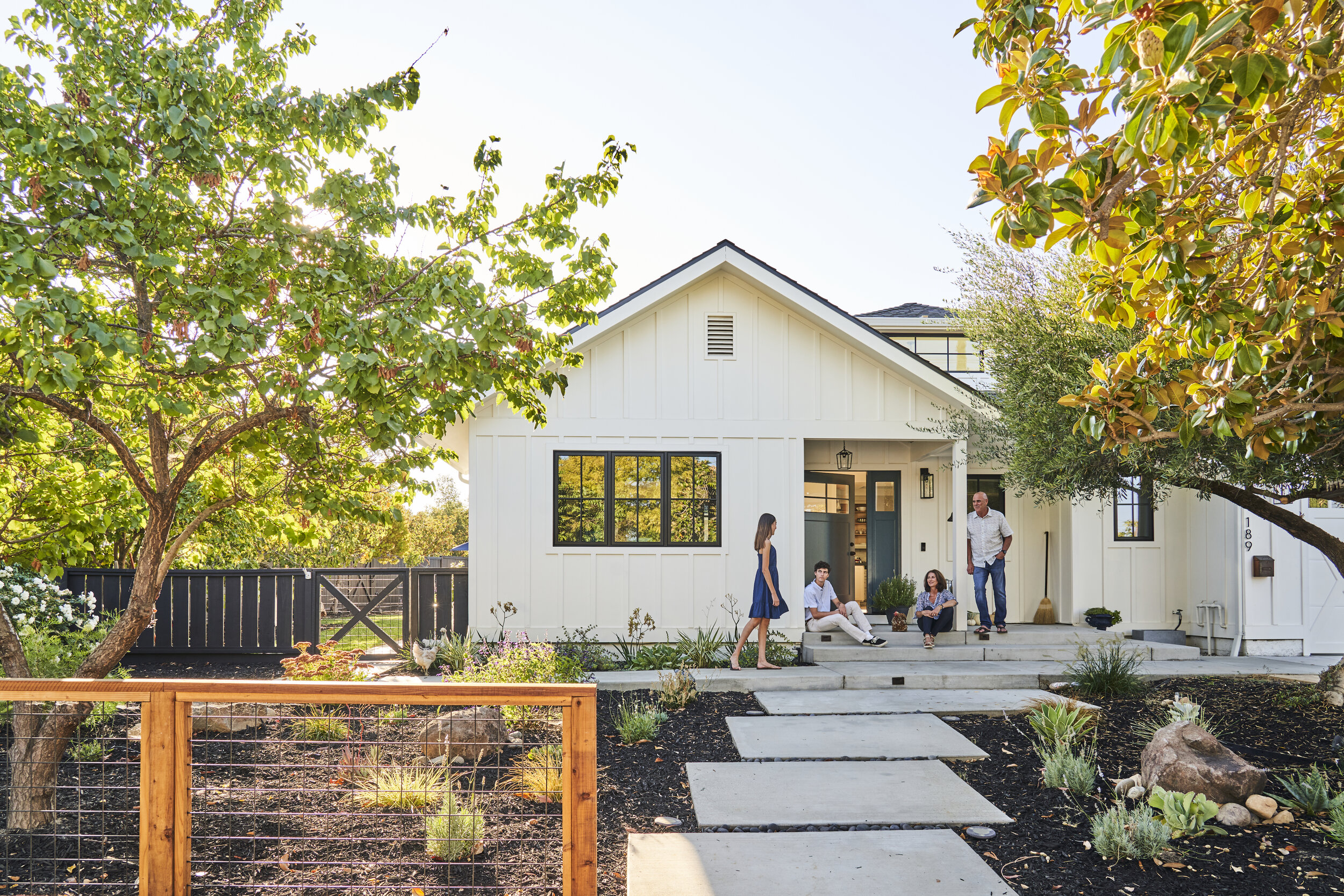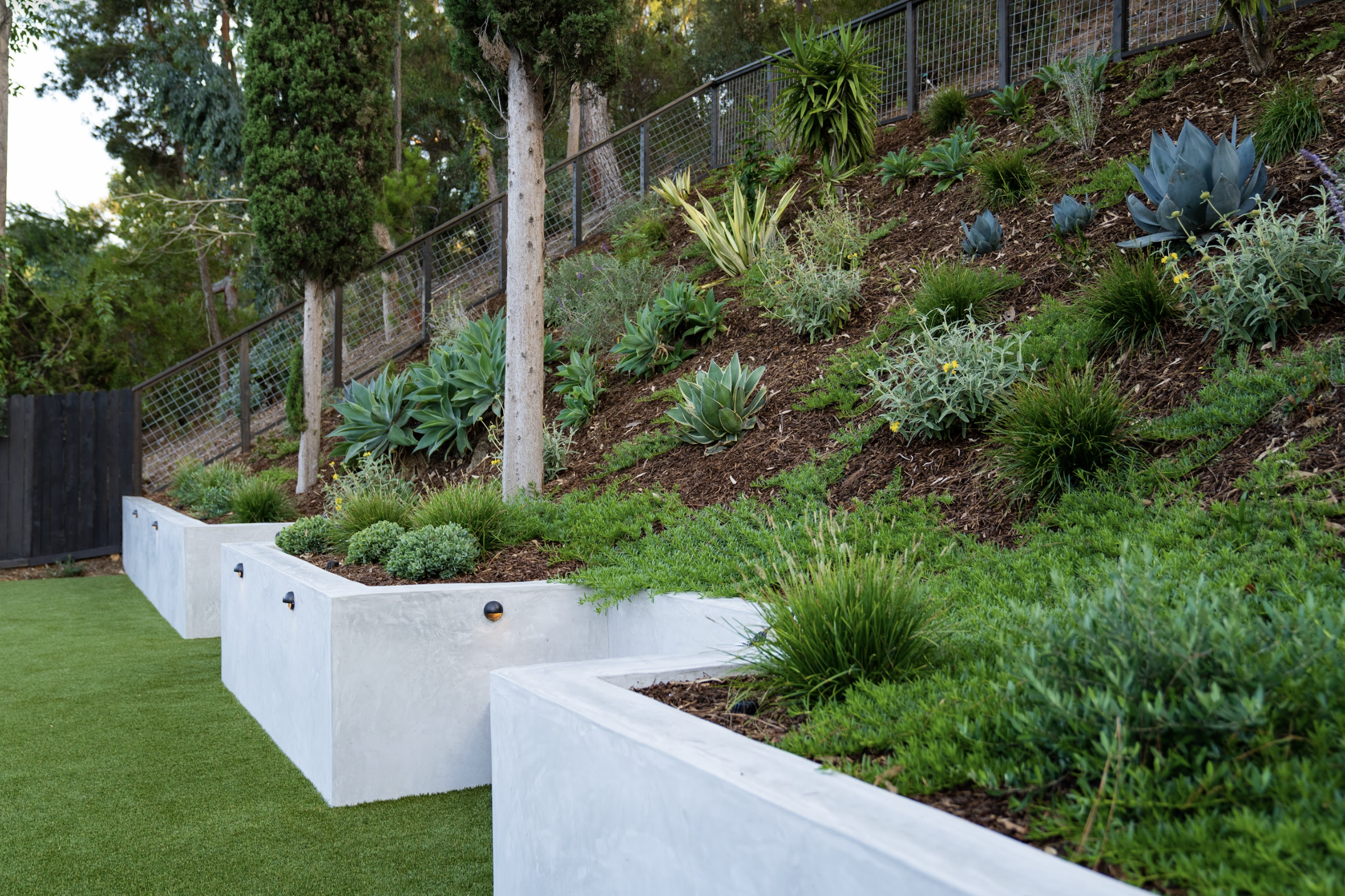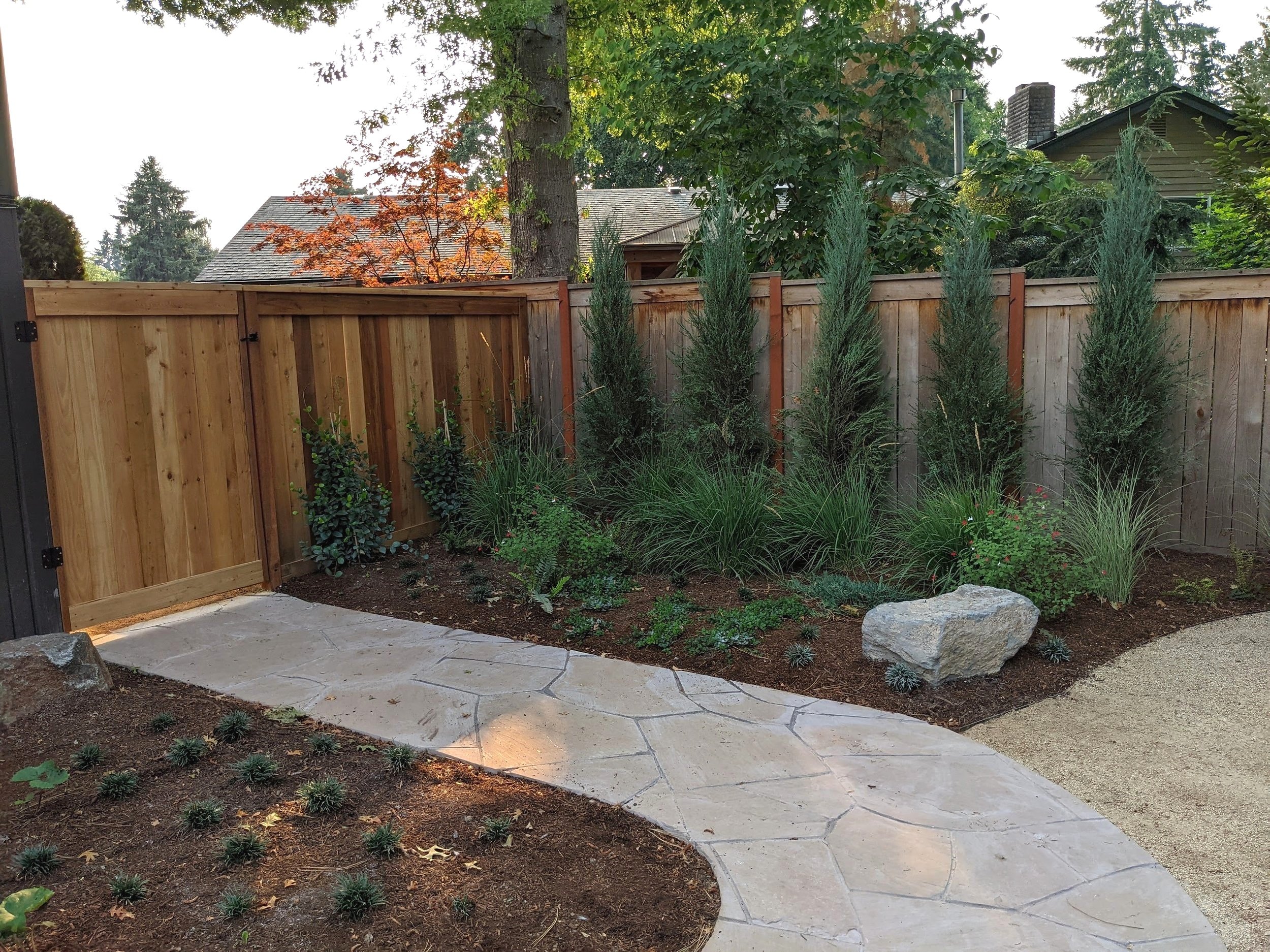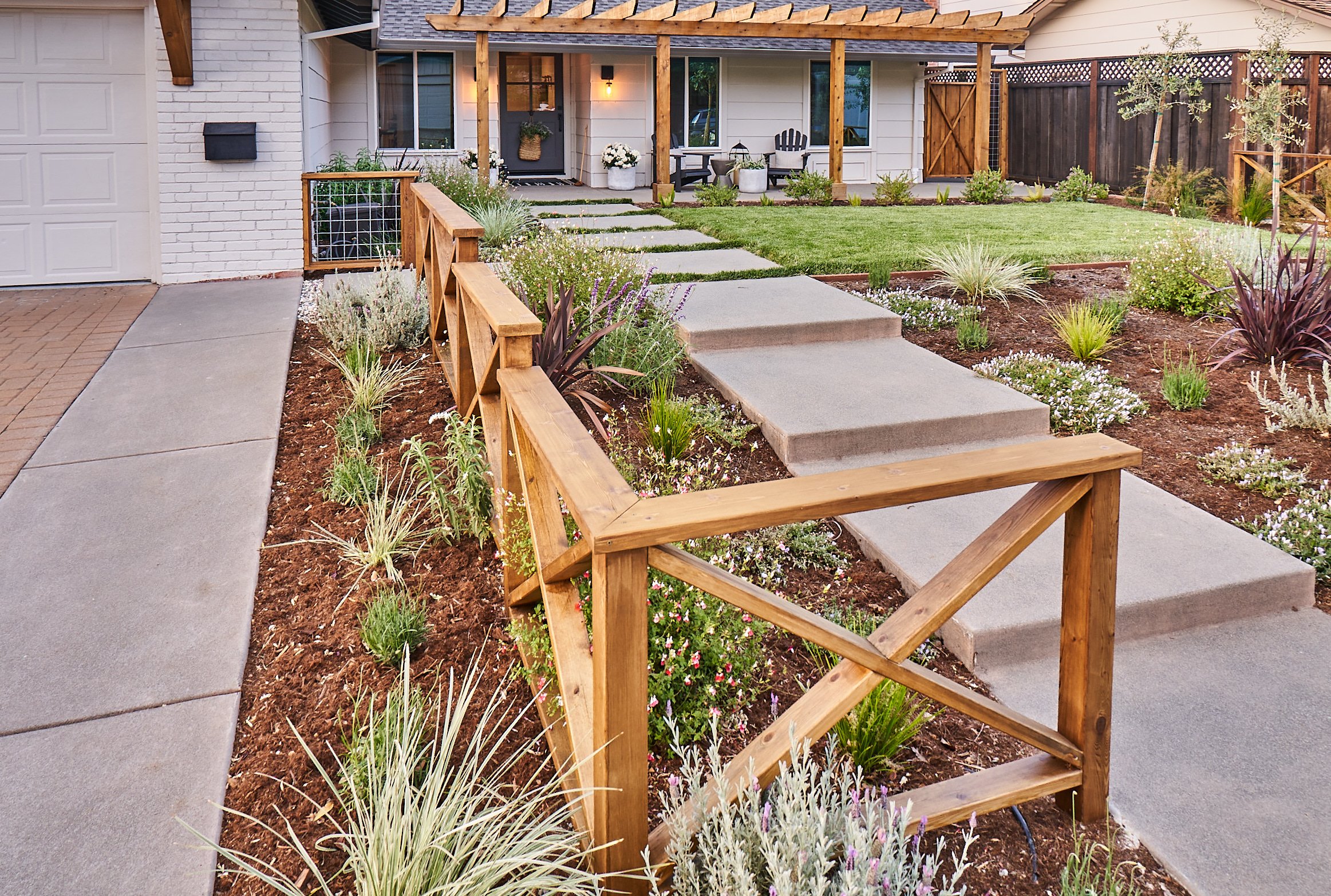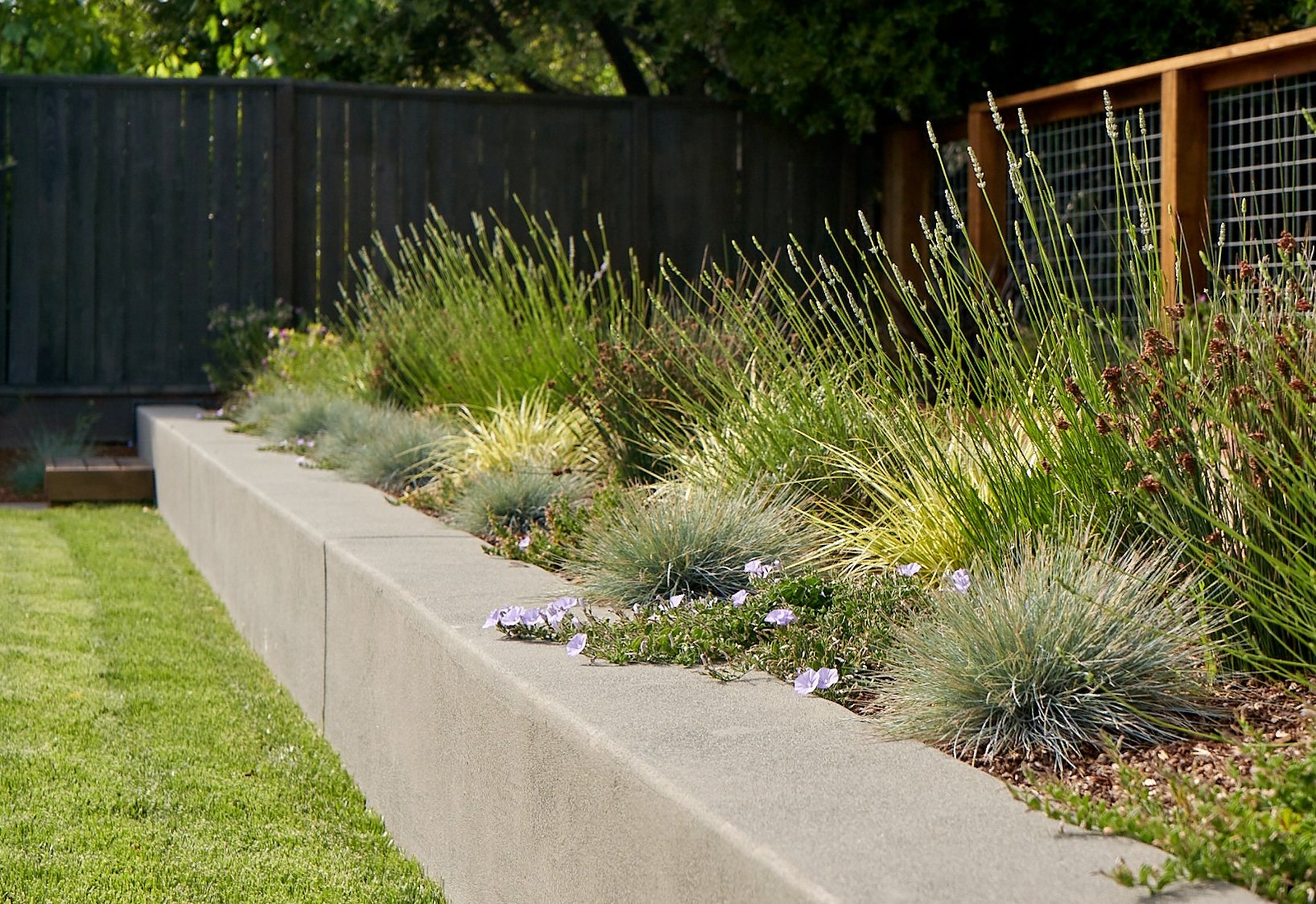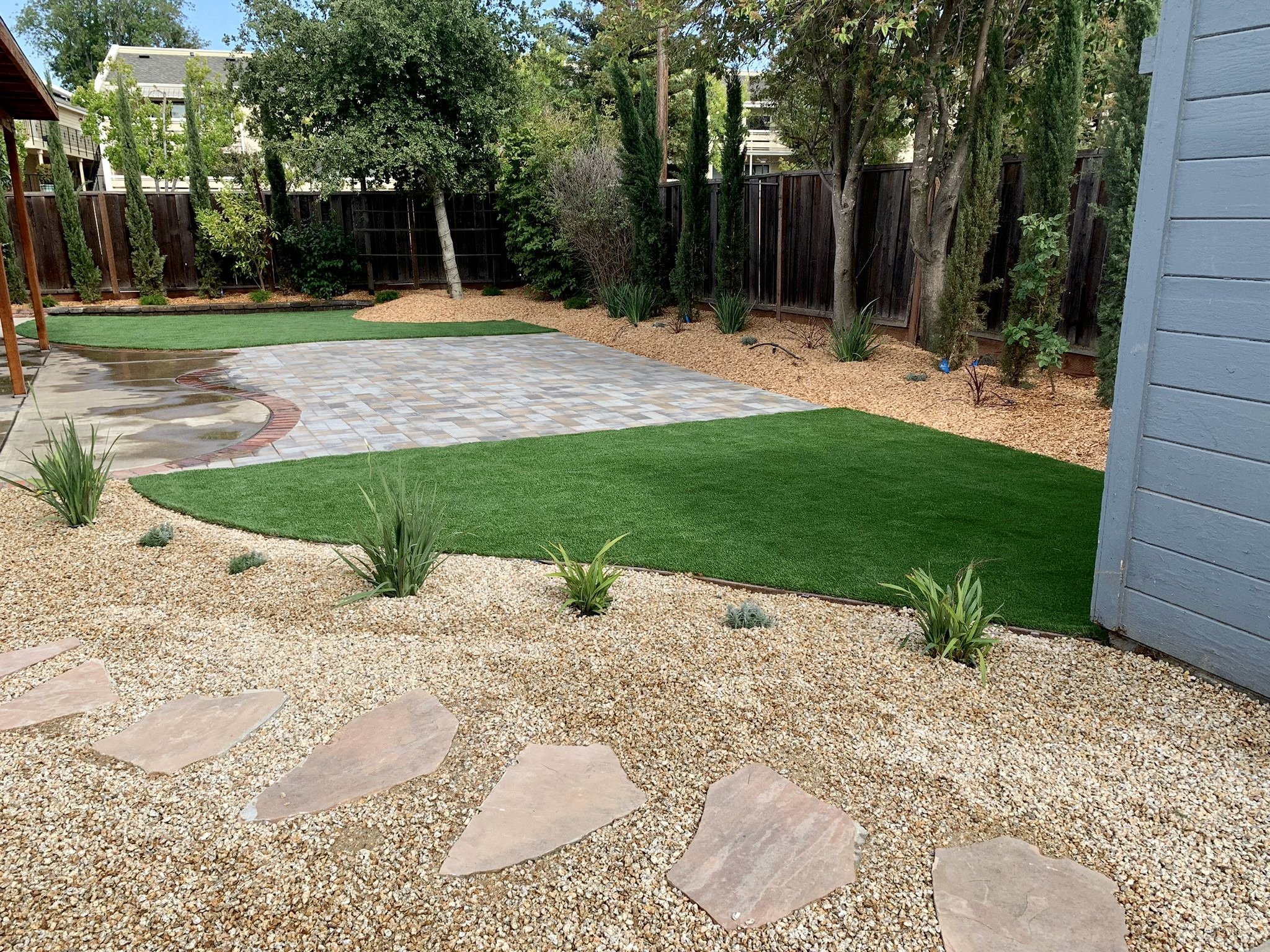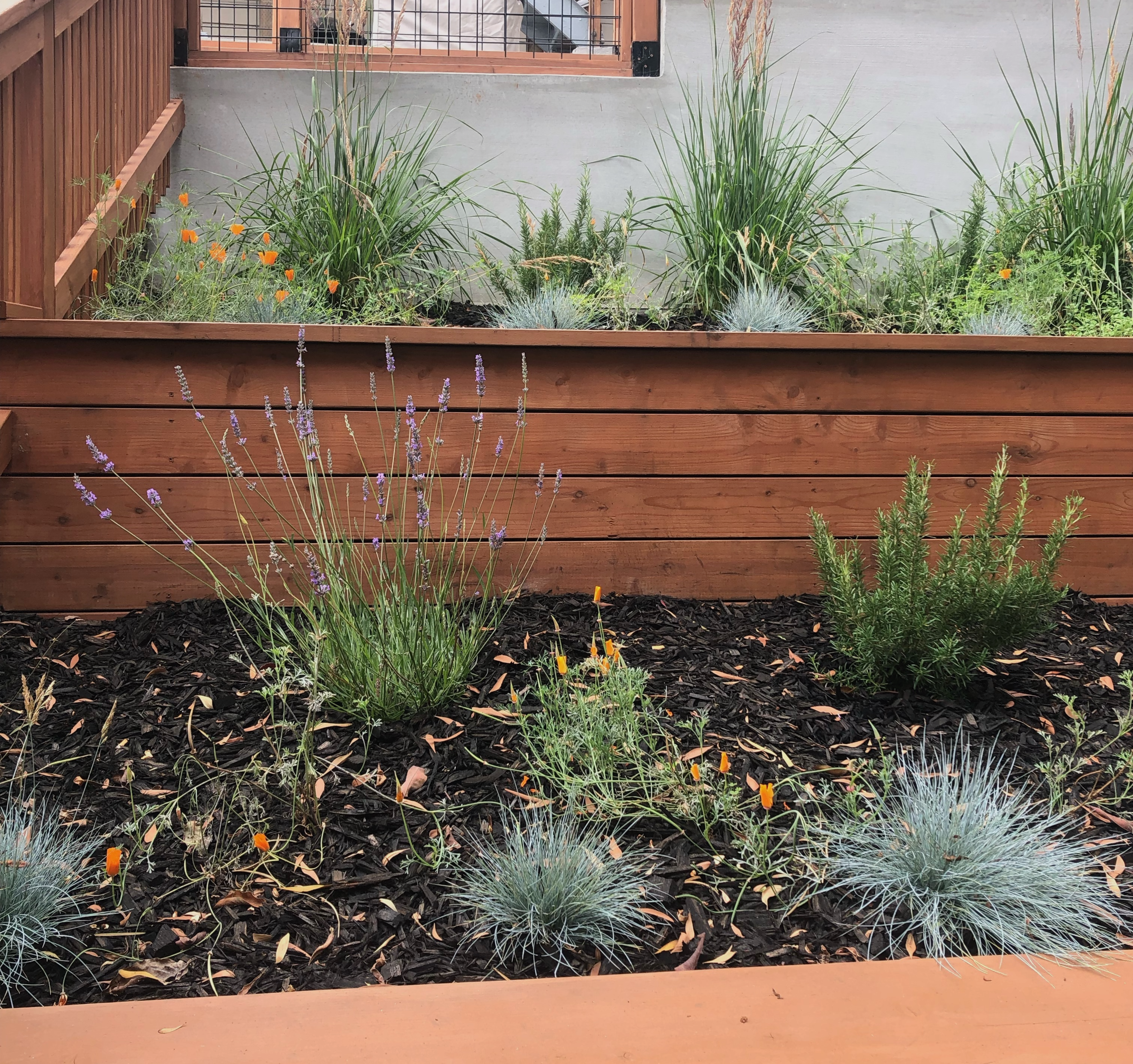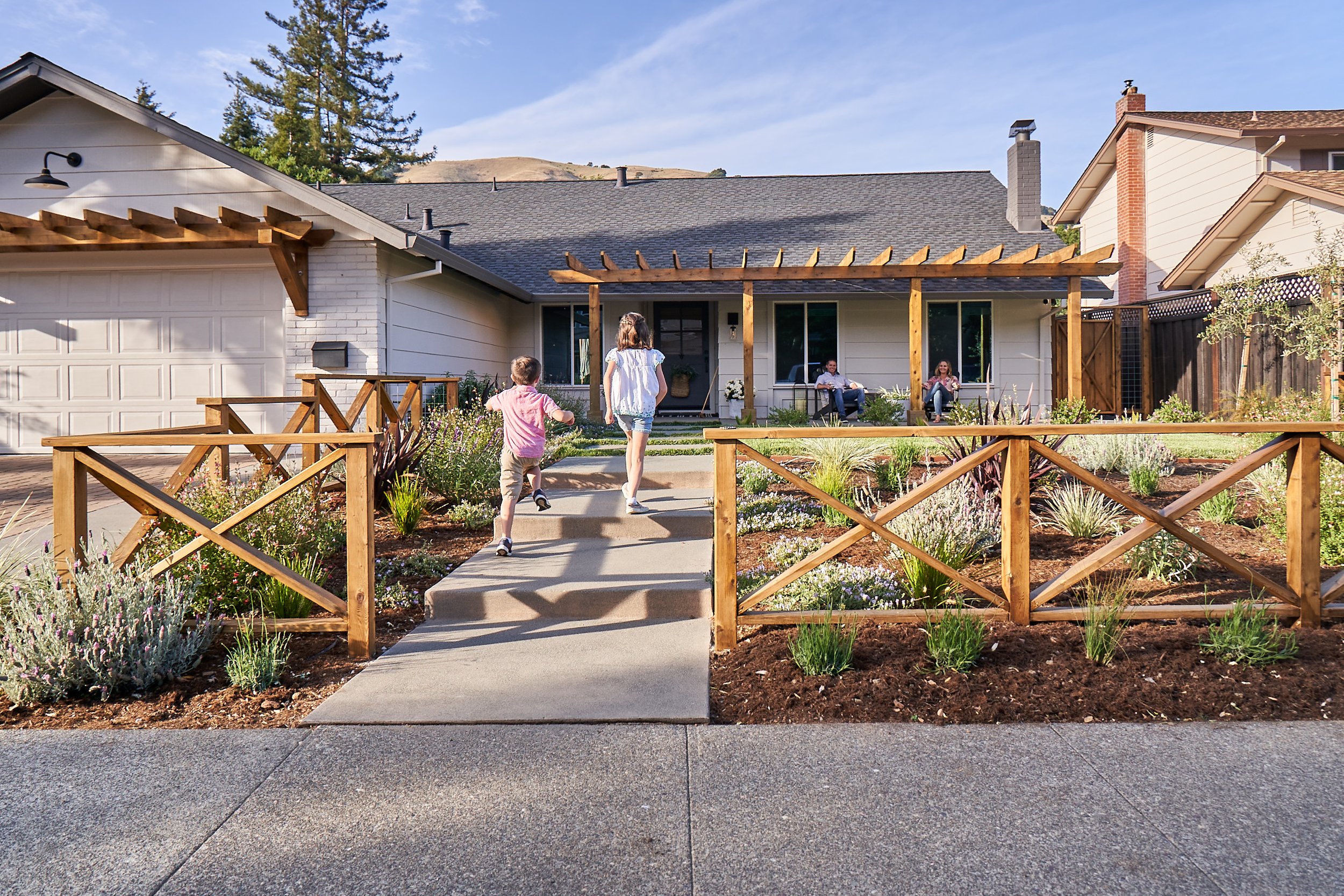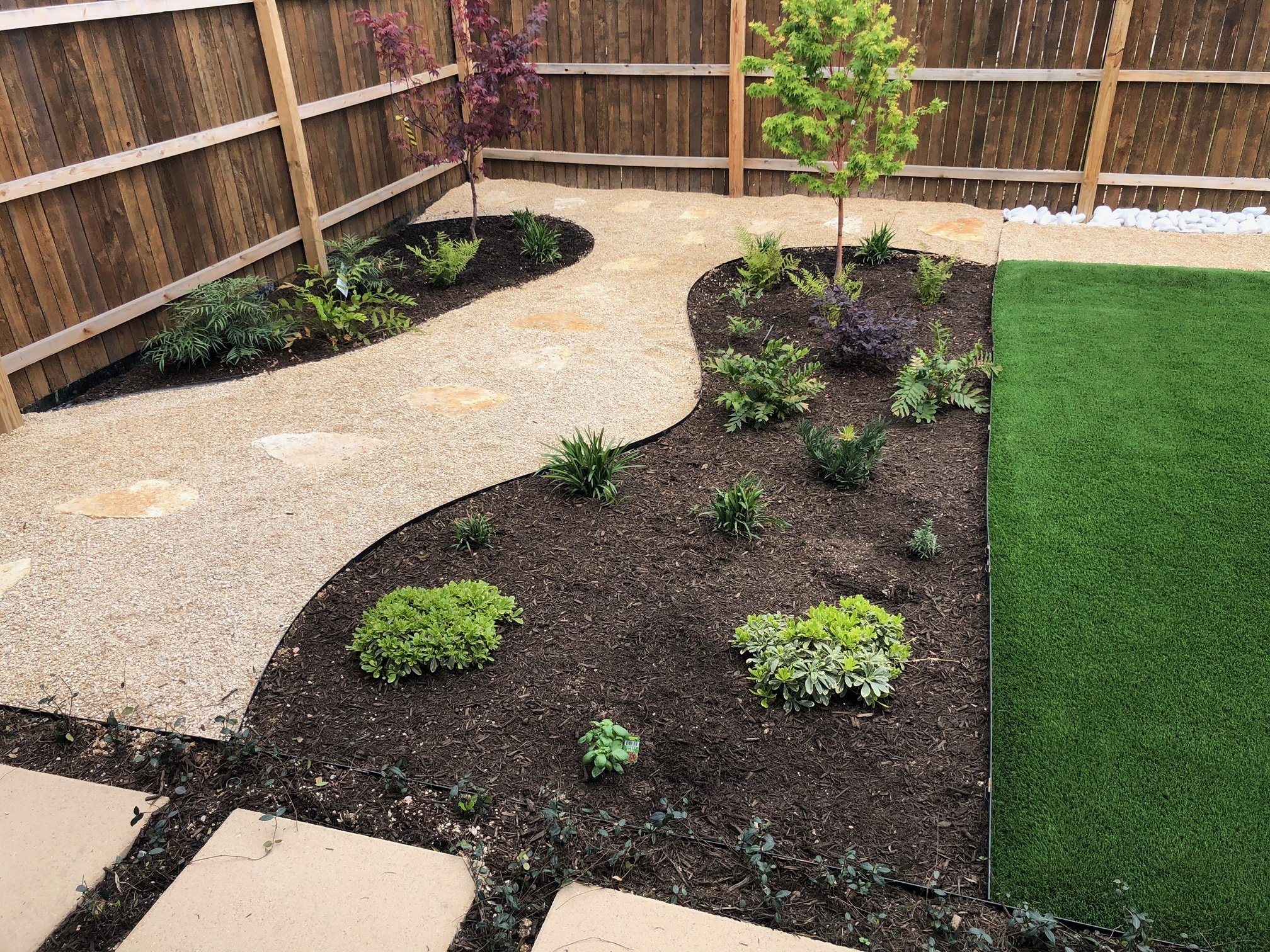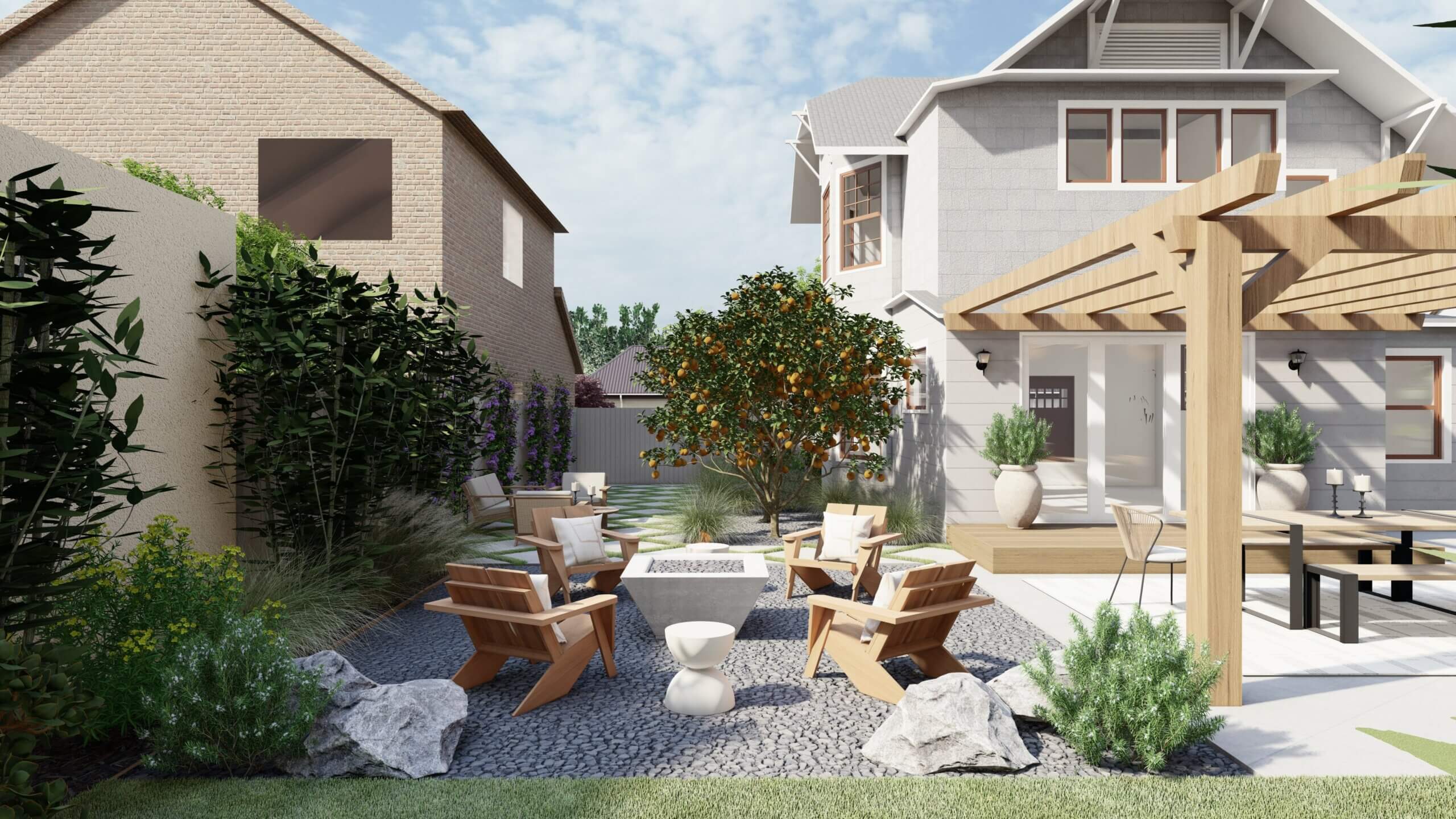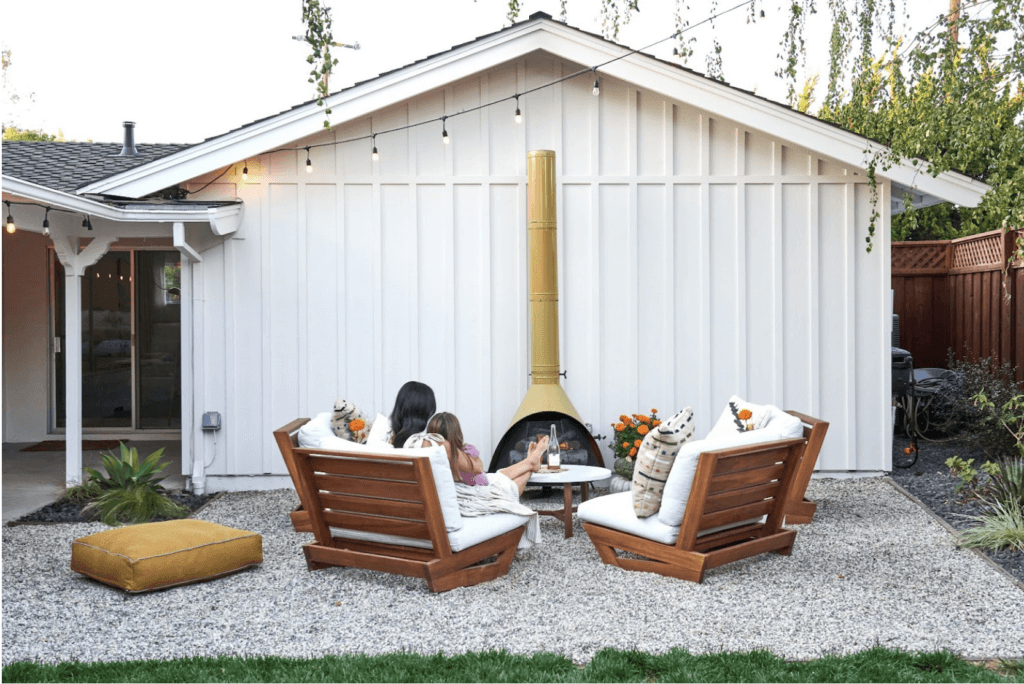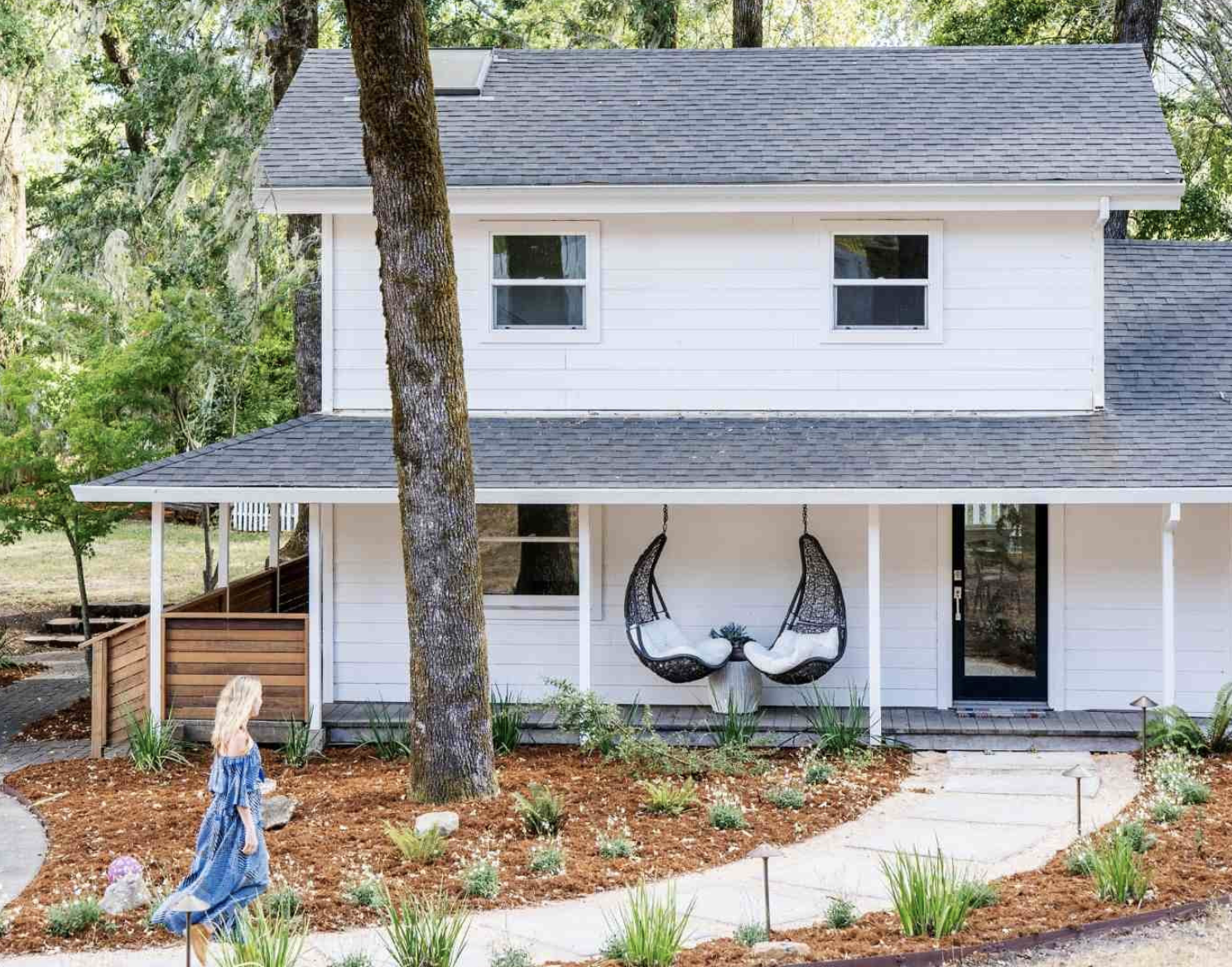
Front yard xeriscaping for Yardzen’s cofounders, Adam and Allison, in their Yardzen-designed yard.
Origin
Water, and the lack thereof, are fundamental concerns in any landscape project. How can we design landscapes to look, feel, and perform how we’d like while also conserving water?
This was a question the folks at Denver Water asked themselves in the early 1980’s. Faced with serious drought, the utility codified a landscape method to drastically reduce the need for irrigation. They called this method “Xeriscaping”, from the latin xer for “dry” and scape for “landscape” or “view”.
In the drought-filled decades since, xeriscaping has taken off, commonly misnomered as “Zero-Scaping” for its emphasis on water conservation.
Get started on your xeriscaping your yard today with a Yardzen landscape designer!
Xeriscaping for a Yardzen front yard
Style
Xeriscaping is fixed in our minds as a method for making desert landscapes— picture a limited palette of rocks, cacti, succulents, and rugged shrubs and grasses. This is, in fact, just one expression of the method, applicable to arid climates like the Southwest.
Wherever you are, xeriscaping should emulate wildland plantings from your region. This could be grasslands, woodlands, even forests. In theory, there are as many styles of xeriscape landscapes as there are naturally occurring plant communities—that is to say, a lot.
A xeriscaped Yardzen backyard
Principles
Denver Water initially defined seven core principles of xeriscaping:
Landscape planning and design
Soil
Limit Lawns
Water Efficient Planting
Efficient irrigation
Mulch
Maintenance
Some practices underlying these principles are centuries old. In this sense, xeriscaping simply put a name to well-established planting practices.
Xeriscaping in a Yardzen backyard in Seattle. A mix of grasses and evergreens make this a rich and lush landscape, unlike popular ideas of xeriscaping as a “desert” garden.
How?
One need not follow the seven xeriscape principles to the letter of the law. If a landscape requires very little or no irrigation to thrive it is essentially a xeriscape. The principles do, however, provide a useful framework to review best practices for creating and maintaining low- or no-water planting designs. We’ll take a quick look at the most important points.
Xeriscaping for a Yardzen front yard
Landscape Planning and Design
To carry out all these described xeriscaping practices, you’ll want to plan ahead with a landscape designer and contractor, like Yardzen. A careful assessment of your existing property will clarify light patterns, heat and wind exposure, and other climate factors. A bit of careful planning up front pays dividends via healthy, fuss-free plants down the road.
A Yardzen front yard with a limited amount of lawn for the kids to play.
Water Efficient Planting
Plant selection may be the most crucial factor in planning a xeriscape design. Plants in a xeriscape must thrive in the local climate, and be happy surviving off natural precipitation alone, save for the occasional nudge from irrigation. People frequently turn to native plants in xeriscape designs, as natives have evolved to do exactly this.
Natives aren’t your only option. Introduced plants from equivalent climate and geographic conditions can perform great in xeriscapes, but best practices recommend exhausting native options first.
Whatever plant species you choose, provide them with the conditions they want. Understory plants, evolved beneath tree canopies, want shade to avoid drying out. Remembering the maxim for xeriscapes to mimic local wildlands, we advise looking to natural plant communities for guidance on what plants to use and where to plant them.
Pro tip: Group plants with similar light and water requirements together – this maximizes plants’ chances at success while minimizing maintenance requirements.
A xeriscaped Yardzen backyard with turf, mulch, and climate-adapted plants
Limit Lawns
Lawns require a lot of water to survive. A 2006 study found that 60% – 80% of household water consumption in the Southwest went to irrigation, and that the majority of that water went to irrigating lawns.
Lawns are also typically overwatered, commonly receiving up to double the irrigation they need to survive.
Xeriscapes can have lawns, but they should be kept as small as possible. We advise skipping ornamental lawns, and keeping lawns for play spaces and other functional uses to a minimum viable size (or, replace them with artificial turf).
Lawns that do make it into xeriscape designs should be put on a water diet – water deeply, but less frequently.
A xeriscaped Yardzen backyard
Efficient Irrigation
All plants require irrigation for their first year or two to get established. Beyond this establishment period, a xeriscape planting design ought to thrive with almost no supplemental irrigation.
This said, weather is increasingly erratic, and an irrigation system is a wise investment to ensure plants do receive the moisture they require.
Any irrigation system – not just those in xeriscapes – should be checked routinely for leaks. It should also incorporate a weather sensor, which cuts operation when wet weather is detected. If you’re the analog type, you can also just manually turn off your system during storms or cool/wet seasons.
We advise watering all plants with drip irrigation, and doing so in the evening. This limits waste and minimizes loss to evaporation.
Lawns are the sole exception: they should be spray irrigated. When designing lawn irrigation, take care to keep all water landing on the lawn, and not on adjacent paving. Avoiding narrow strips and odd shapes makes this easy.
Efficient water management goes hand in hand with irrigation efficiency. Water, be it irrigation runoff or precipitation, should be captured and infiltrated on site as much as possible. This recharges groundwater supply and offsets irrigation needs. It also helps to reduce flooding and pollution in local waterways.
Pro Tip: maximize permeable surfaces to capture as much water as possible. Groundcover plants are exceptional at detaining water and coaxing it back into the ground, but if you prefer less vegetative cover, beds of gravel or other loose aggregates can be placed adjacent to paving to capture runoff before it reaches the gutter.
Xeriscaping for a tiered Yardzen backyard
Soil
Soil conditions are as important to plant health as light and water. Soil type also influences the rate at which water soaks into the ground, and how long water will remain suspended in the root zone for plants to access.
Because yard soil is often disturbed or low in quality, xeriscape principles suggest amending soil with organic matter (compost made from local leaves is a safe bet). The higher the organic matter, the greater the soil’s capacity to retain water, and the less you’ll need to supplement with irrigation.
Before you go wild with the compost, though, take a moment to see what your plants really want from their soil.
Plants evolve in all types of soil conditions. Species adapted to poor soils are likely to suffer under heavy fertilization. If you are planting natives adapted to local soil conditions, success may come most readily by simply skipping soil amendment – some plants just want to be left alone.
Be they native or introduced, try to place plants in soil conditions they’re accustomed to. This takes a bit of research, but not much, and it will save you labor down the road, especially if you group plants with similar soil preferences together.
This Yardzen front yard make beautiful use of mulch for curb appeal
Mulch
Xeriscape gardens lean heavily on mulch, and for good reason. Mulch preserves soil moisture, insulates against soil temperature swings, and blocks weeds that would otherwise compete for water with your designed plantings.
Bark mulch can be kicked or blown around, leading to a bit of a mess in certain conditions. Rock mulch holds its ground better, and is commonly used in xeriscapes to evoke a desert aesthetic.
A word of caution: rock mulch absorbs sunlight during the day, and reradiates heat at night, warming the soil. For heat-tolerant plants, this is not necessarily a problem, but for most plants warmer soil leads to water loss and increased irrigation needs.
If rock mulch is an aesthetic must, try it in shaded areas where it won’t absorb and emit as much heat.
The ultimate mulch is not a mulch at all: groundcover plants. These low, fast-spreading species are superior to mulch in their capacity to improve soil health, infiltration rates, and water retention, which offsets irrigation needs. They also lower ground temperatures, and help to cool incoming breezes that blow above them. Native groundcovers especially – when planted in the conditions they like—often thrive with little to no inputs, and won’t require the annual replacement that bark mulch does.
A xeriscaped Yardzen backyard in Seattle
Maintenance
Done correctly, xeriscapes require less maintenance than traditional landscapes. Simply by reducing lawn size you will slash your maintenance requirements.
Careful plant selection and placement—choosing climate appropriate plants, grouping them by shared preferences, and placing them in conditions they enjoy—creates conditions for plants to take care of themselves, without much help at all from homeowners.
Benefits amplify in planting designs that heavily feature natives, which, due to their local adaptation, tend to require less care and fewer inputs of water, pesticides, and fertilizer than introduced species.
Water savings and reduced maintenance translate to cost savings—one study links xeriscapes in Nevada to 50% reductions in annual water bills, and 70% reductions during hot summer months.
Pro tip: As an added perk, natives also provide habitat for local fauna. Introduced plants can go toe-to-toe with natives in terms of climate tolerance, but they pale in comparison in terms of habitat value. If you want butterflies and birds to frequent your garden, natives are the way to go.
Get started on your xeriscaping your yard today with a Yardzen landscape designer!
Featured Articles
How an Interior Designer Created “Outdoor Rooms” in Her Yardzen Yard

The Best Outdoor Cold Plunge Tubs & Ice Baths in 2024 (Chosen by Our Client...

Our Dreamiest Plunge Pool Yard Designs
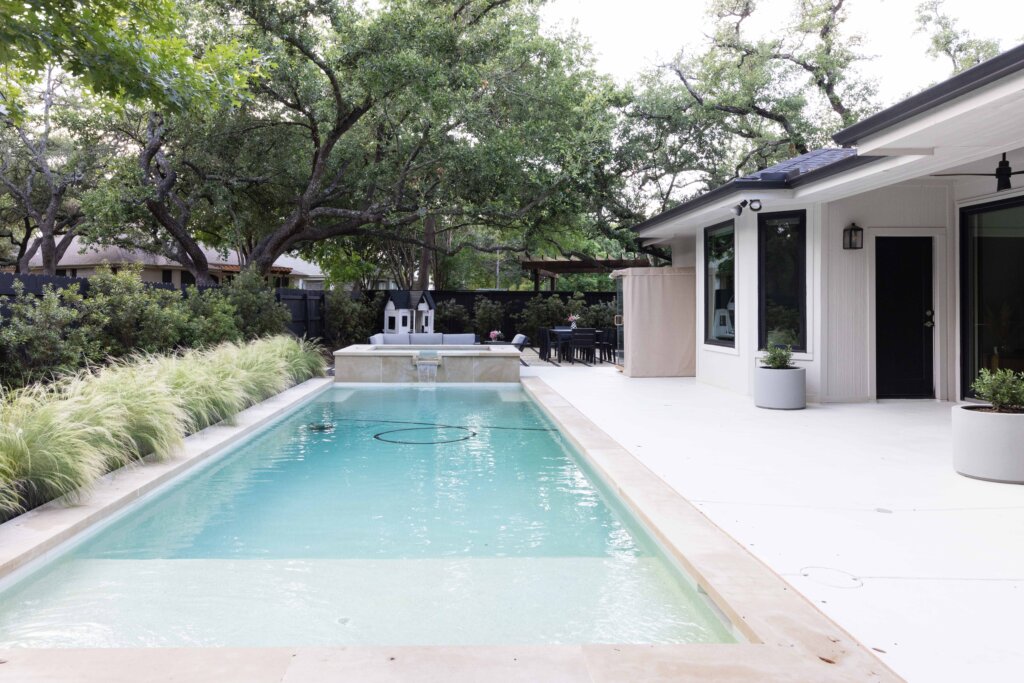
Our Favorite No-Grass Front Yard Ideas


